Harvest Home&
Master Gardener volunteers are trained to serve their communities
Harvest time offers more than pumpkins and sunflowers
Outdoor maintenance: 8 must-do tasks before winter
Interior maintenance: What to focus on this fall & more!
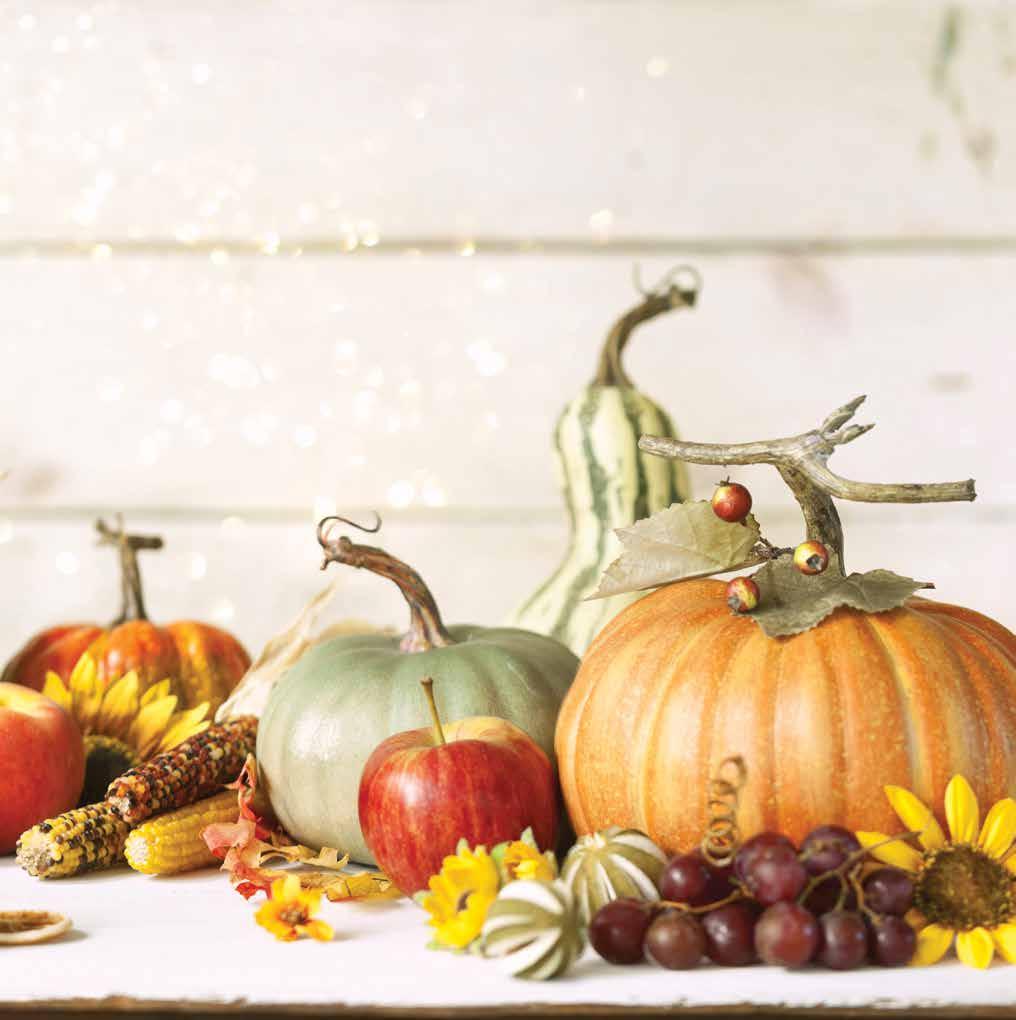
A Special Supplement to The Daily Star Wednesday, Sept. 24, 2025
Master Gardener volunteers are trained to serve their communities
By Monica calzolari
Contributing Writer
Every other year, the cornell cooperative Extension of Schoharie and otsego counties offers a Master Gardener program that runs from october through March. This year’s deadline has passed, and volunteers will soon begin training. Participation has varied yearto-year from 10-20 people. if this year’s class is not full, there may be a chance to join. a $250 application fee is required. limited scholarships are available. Details can be found at https://cceschoharieotsego.org/.
The program is an opportunity “to learn about horticulture, receive practical instruction from ccE staff and other experts, and meet and work with like-minded individuals,” said Marcie Foster, horticulture and natural resource educator at cornell cooperative Extension.
chris Burrington, a member of oneonta’s community Garden, is an avid gardener who completed the Master Gardener program about 14 years ago. “you learn about botany, trees, grasses and soil, plus how to identify invasives and different varieties of plants,” Burrington said.
What Burrington liked best about the Mas-
ter Gardener program was “you get to meet all these other kindred spirits.”
This year, the training will be hybrid. The course will be self-guided online with weekly live zoom presentations from 6 to 8 p.m. every Wednesday, plus some in-person sessions.
“There will be weekly live zoom sessions. These will be presentations by professionals on topics that tie into what people will be learning online. Finally, we will be holding six to eight in-person sessions mostly on Saturdays,” Foster said.
“The in-person sessions will be held either in cooperstown or cobleskill. We’ll cover topics such as soil testing, composting, hydroponics and seed starting. The in-person session will also include tours of local greenhouses, garden centers and college facilities,” she said.
Janet Sutta completed the Master Gardener program during the coViD-19 pandemic, when the course was 100% online. Being from new york city with no gardening background, she found that she is a hands-on learner. She joined oneonta’s community garden.
“i grew peas, kale, radishes, mustard and carrots,” she said. “i learned everything walking around and looking at what everybody else is doing.”
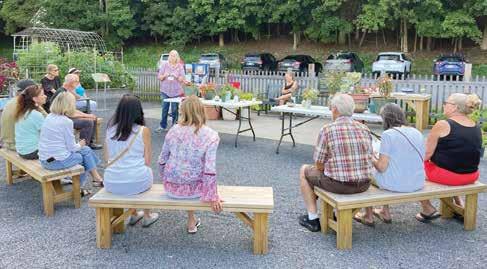
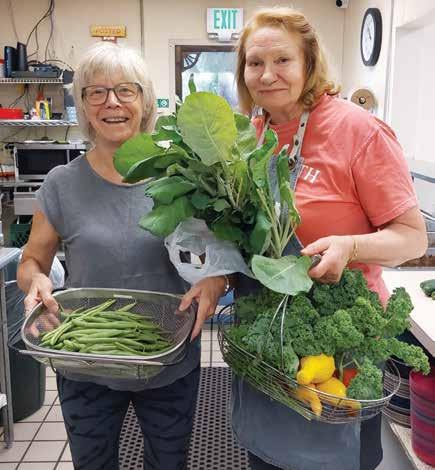
Master Gardeners volunteers enjoy people and plants. They usually have no professional gardening or landscaping experience, only a genuine interest in sharing their knowledge, and sufficient free time to volunteer in Master Gardener activities.”
— Marcie Foster
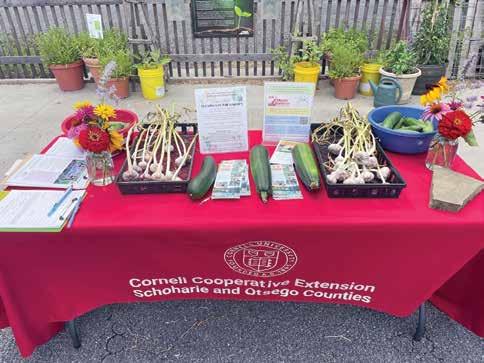
Cooperative Extension offers a Master Gardener program every other year and does multiple events including an Otsego Garden tabling event, such as this one from 2024.
Sharing knowledge with like-minded individuals is a component of the Master Gardener program, also.
“Summer is when gardens grow,” Burrington said. “Fall is when you put your garden to bed, renew the soil, and save seeds.”
“in october, plant your garlic,” she said. “Garlic grows all winter and is ready for harvest in July.”
The Master Gardener program is a public service program. “Master Gardeners volunteers enjoy people and plants. They usually have no professional gardening or landscaping experience, only a genuine interest in sharing their knowledge, and sufficient free time to volunteer in Master Gardener activities,” Foster said.
ccESo is a two-county association with about 30 active Master Gardener Volunteers in otsego county and about 10 in Schoharie county.
“ccESo has trained and our counties have benefitted from the volunteer activities of hundreds of MGVs over the decades,” said liz callahan, executive director of the agency.
“last year our Master Gardeners answered over 150 questions from the public,” Foster said.
The program began in new york state in 1975. The ccE Master Gardener program is administered at the county level. according to the cornell cooperative
Extension website, “The MGV program was initiated in 1972 in Seattle. David Gibby, Washington State University King county extension agent, realized that keeping up with the growing number of gardening questions coming into his office was a losing battle.”
The ccE has some fact sheets and information about managing deer in urban settings, too.
“We do talk a lot about deer resistant plants. … one resource that we have found especially helpful with deer resistant plants is the rutgers new Jersey agricultural Experiment Station (landscape Plants rated by Deer resistance,” Foster said.
cornell cooperative Extension offers locals many resources every month. Some events in September include a plant sale, seed-saving and tomato tasting, Burrington said.
Burrington donates all the vegetables she grows in her community garden plot to your Safe Haven, a local food pantry that serves hot dinners to people in need five days a week.
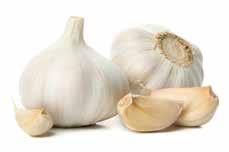
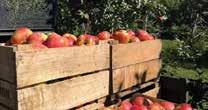

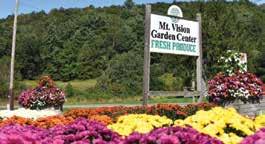





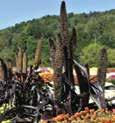

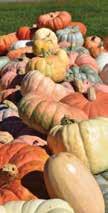



Harvest time offers more than pumpkins and sunflowers
By Monica calzolari
Contributing Writer
one of the advantages of living in a rural area surrounded by farms, big and small, is buying fresh fruits, produce, flowers, meats, honey, apple cider and maple syrup directly from the people who produce them.
Thistlemint Farm and arK Floral sell their specialties at the Delhi Farmers’ Market every Wednesday from 10 a.m. to 2 p.m. and the oneonta Farmers’ Market every Saturday from 9 a.m. to noon. Both markets are open year-round. Delhi’s summer market is on the courthouse Square on Main Street in Delhi. oneonta’s summer market is in Huntington Memorial Park on Dietz Street.
Thistlemint Farm grows organic vegetables on its 1 1/2-acre farm in laurens. They are in their fourth growing season. Four co-owners got together back in
2021. “We sell some herbs, but mostly vegetables,” Mische Henderson-Tomowski, one of owners, said.
“They put a lot of care into their produce,” Sohail zandi, chef and owner of Brushland Eating House, said as he bought tomatoes, carrots and fresh ginger for his restaurant.
“They pick their carrots a little younger,” zandi said.
“i think Thistlemint has some of the best-tasting vegetables i have had in 25 years,” said catherine Herr who operates a catering company called new Day Kitchen in Delhi.
“Their organic practices are very trust-
worthy,” Herr said. She also likes that she can order in bulk from Thistlemint when cooking for retreats and wellness events. Herr bought a bunch of hot peppers from Thistlemint, planning to make a recipe from Bhutan, a kingdom near india, nepal and china.
Thistlemint also sells blank greeting cards that have images of the produce they grow. “We all do art,” Henderson-Tomowski said.
arK Floral has been in the Kennedy family for about 50 years.
“This is sunflower season,” Meg Kennedy said. “i’ve done successive plantings of sunflowers and will have them available through columbus Day in early october.”
Kennedy manages the Delhi Farmers’ Market for the Delhi chamber of commerce and is also on the board for the oneonta agricultural Group, which runs the oneonta Farmers’ Market. She is one
Every dollar you spend locally has a multiplier effect. The money spent shopping locally allows the family-owned farms to be sustainable.”
— Meg Kennedy of the vendors at both markets.
She stressed the importance of farmers’ markets to economic development.
“Every dollar you spend locally has a multiplier effect,” she said. The money spent shopping locally allows the family-owned farms to be sustainable.
Eleanor Blakeslee operates Berry Brook Farm in Hamden. She started the 15-acre farm in 2012 and has been selling at the Delhi Farmers’ Market since 2015. She has 10 employees who help sell produce at five farmers’ markets.
“This market (in Delhi) got really big after coViD,” she said, “when a lot of people moved here from downstate.” one of her customers, reagan reed, said, “They don’t use pesticides. They have the best organic vegetables around.”
“My son and daughter really love her
carrots,” reed said. Tyler and lily reed, age 10, munched on raw carrots on Wednesday, Sept. 3. “They are sweet,” lily said.
apples, apple cider and applesauce are three of the items Green Sun orchard & cidery offers at the Delhi Farmers’ Market. Ben and Karen Gery operate a 5 1/2acre orchard in Trout creek and a winery in Walton.
“We grow mostly tree fruit,” Ben Gery said. “Plums, pears, apples, blueberries and grapes,” his wife, Karen, said.
Wright ceresola, age 5, of oneonta, stopped by for some apple cider, on Sept. 3. His mother, Meghan Sheehy, promised to do something special the day before he started kindergarten at riverside Elementary School. They went to Delhi’s Farmers’ Market.












































Why it pays to create a mudroom in a home
considerations for room additions or space modifications generally involve rooms that will add value or function to a home. Mudrooms certainly fit that description, as they can add aesthetic appeal in more ways than one.
as the name implies, mudrooms are entire rooms or areas near entryways of homes where muddy shoes and other items can be stored. By having a set space for
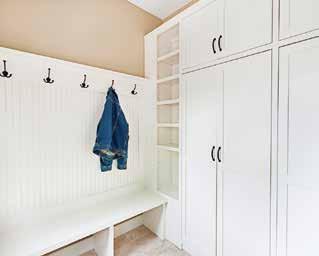
messy shoes and coats, homeowners do not need to worry about dirt and other debris being tracked throughout the home. Mudrooms also can provide a welcoming space for guests.
Homeowners who have adequate space to add an entirely new room may have no difficulty putting in a mudroom. a mudroom addition is a job best left to a professional. ideally, this new mudroom can be adjacent to an entry by the garage, or a side or back door. The footprint of the mudroom needn’t be too large, either. a ll it requires is a small amount of space to place a bench, coat hooks and shoe storage.
according to This old House, homeowners also can convert a porch, create a mudroom by expanding into an adjacent room or closet, or even repurpose space in an attached garage. U.S. news and World report indicates that a well planned and executed mudroom has the potential to increase a home’s value. Depending on the scope of the work, the average cost of a mudroom project ranges from $2,500 for a simple porch conversion to $30,000 when a new foundation is needed and the build-out is extensive.
Budget-conscious homeowners can create a mudroom in an existing foyer or another entryway. ade-
quate storage is essential for any mudroom, and should include coat racks, hooks, a bench to facilitate removing shoes safely, shoe storage, and additional considerations, like shopping bag storage or umbrella holders. creating a door from the outside into an existing laundry room can enable homeowners to use the space as both a mudroom and laundry area with minimal changes necessary.
There are some extra considerations for mudrooms that homeowners should think about. The flooring, walls and furniture/storage used in the mudroom should be durable and easily cleaned. as wet and dirty shoes and clothing will be in the space, it’s essential to make clean-up a breeze. look for nonslip flooring so entering the mudroom safely is not an issue. a lthough a mudroom is a utilitarian space, creature comforts can be added to integrate the space with the rest of the home. cover a storage bench with indoor-outdoor fabric that coordinates to the colors used in a home. add some decorative drawer pulls and cabinet hardware to elevate the space. Washable throw rugs also can add some design appeal to the room. Mudrooms can be useful spaces that add function and value to homes.


Ready your home for the winter chill
outdoor maintenance 8 must-do tasks before winter
it’s no secret: northern winters are harsh! if you want your property to make it through the cold season without any issues, you have certain tasks that must be completed this fall. check out this handy checklist to ensure you don’t miss anything.
1. Close your pool. Drain the water, remove the ladder, clean the filter and install the protective cover. you know the drill!
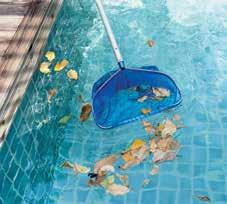
2. Put away seasonal items. Empty and put away your garden hoses and turn off the outdoor taps. clean and store your patio furniture and accessories, summer games and toys and the barbecue, or cover them with a sturdy tarp.
3. Maintain your chimney. Minimize the risk of a fire by sweeping your chimney. a lso, check the condition of the cap to ensure no unwanted animals make a home in your chimney.
4. Inspect the roof, walls and foundation. look for damaged shingles, missing gravel, tears in the membrane or cracks, and make any necessary repairs to prevent leaks.
5. Clear gutters and drains. Wait until
all the leaves have fallen, then clear out the gutters and drains to prevent overflows and water damage.
6. Install screens on vents. Vents from range hoods and dryers are irresistible entry points for many creatures seeking warmth. install new screens or replace damaged ones to keep your home secure.
7. Protect your plants. Shield your shrubs, bring in potted plants, divide perennials, pull up annuals, plant fall bulbs, aerate the soil and trim any hedges. Prune trees as needed to prevent branches from falling on your house in a storm.
8. Clean up the yard. rake up dead leaves and any debris that could shelter rodents or attract insects.
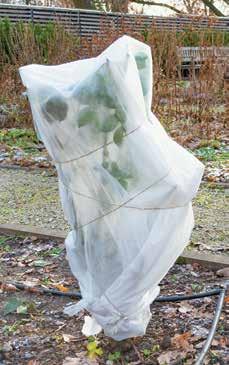
interior maintenance
What to focus on this fall
What could be better than curling up at home, sheltered from the snow and wind on a cold winter day? as fall arrives, take the time to inspect and maintain these key elements inside your home.
Windows and doors
Keep the heat in and the cold out by reapplying caulking, installing plastic window sheeting and replacing damaged weatherstrip. you should also remove window screens to prevent condensation and potential breakage.
Detectors
Test your smoke and carbon monoxide detectors by pressing the test button until you hear the alarm. if needed, or if it’s been a while, replace the batteries. While you’re at it, inspect your fire extinguishers to ensure the tamper seal and safety pin are still intact.
Heating system
check your heating system to ensure it’s working properly before the winter
chill sets in. Vacuum your baseboard heaters or wall-mounted convectors to prevent unpleasant odors. a lso, make sure no flammable objects, like curtains or cushions, are with four inches of them. consider scheduling a professional inspection if it’s been a while since your last check.
Air exchanger
Wash the unit’s filter and air vents. Then, remove them entirely to vacuum and clean out as much dust and debris as possible.
Sump pump
Pour a bucket of water into the tank slowly. if the pump starts immediately, it’s working as it should.
Air conditioner
clean the filters on your wallmounted or window air conditioner. Then, either store it away from the elements or protect it with a cover or case. once you complete these tasks, you’ll be ready to face winter in a warm, cozy home.
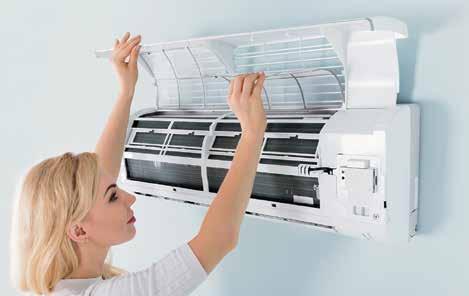
Weigh the pros and cons of mini-splits before you buy
By Monica calzolari
Contributing Writer
Mini splits are a popular alternative to conventional heating, ventilation and air conditioning.
Financial incentives have increased interest in the product. a federal tax credit rebate of $2,000 on mini-splits ends Dec. 31. other equipment rebates are available through the new york State Energy research and Development authority, known as nySErDa
cornell cooperative Extension and nySErDa operate 12 energy hubs throughout the state. lucas russell is a community energy advisor with cornell cooperative. He serves six counties, including otsego and Schoharie.
He said, “natural gas is the most effective means of heating your home.” Heat produced by furnaces are what the majority of the older homes in this area have. Mini-splits are powered by electricity. Therefore, they are considered cleaner and greener for the environment. The cost of electricity has recently increased. new york state’s clean Heat Program is a program implemented through new york’s utilities, such as nySEG and national Grid, to install heat pumps which power mini splits.
Because mini-splits operate without combustion, they produce fewer emissions going into the atmosphere, russell said.
“oil and kerosene release carbons into the atmosphere and have a greenhouse effect on the environment,” he said. replacing a fossil fuel heating system (gas or oil) is a trend.
another disadvantage of oil heat is that a full tank of oil can cost as much as $900 according to russell. oil also requires delivery which adds to the cost. if you are deciding whether to replace your heating system or add air conditioning, the layout and construction of your home and your budget are primary considerations.
one advantage of mini splits is they supply both cooling and heating.
choosing the right HVac system is complicated. Josh Gregory, owner of Gregory Plumbing and Heating in oneonta, recommends that buyers get a qualified plumbing and heating professional to evaluate their home or commercial building before investing in a solution.
Gregory Plumbing does not install mini splits despite their popularity and tax incentives.
“a typical heat pump system that is air-source costs $25,000 to $30,000,” russell said. “a ground source, which requires significant excavation to dig trenches and bury cables underground, usually costs around $50,000 to $75,000.”
a common misconception is that if you buy a HVac


Mini splits are standalone units that are mounted on the wall just below the ceiling and blow hot and cold air to heat or cool rooms. They are connected by hoses to an air source heat pump installed on the outside of a home or commercial building.
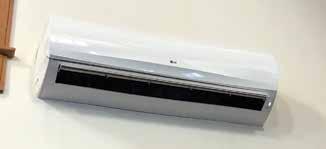
system that is 95% energy efficient, you’ll save money on your energy bills each month, Gregory said. if your home is not well insulated and you have heat going out your windows, the mini splits will run constantly and not be as efficient, he warned.
Mini splits are standalone units that are mounted on the wall just below the ceiling and blow hot and cold air to heat or cool rooms. They are connected by hoses to an air source heat pump installed on the outside of a home or commercial building.
central heating and central air conditioning systems require extensive duct work, which adds to the cost of installation because it is labor-intensive. The duct work travels from the attic through the floorboards all the way to the basement of a home.
Mini splits do not require internal duct work. The hoses attached to mini-splits carry the refrigerant. The air source heat pump is installed on the outside of the building. it sucks hot air out of your home.
Hartwick college’s facilities manager, Scott Harrington, had mini splits installed in certain rooms around campus more than 10 years ago. The technology is not new, he said.
“They are great to supplement heat during the winter,” he said. a mini split hangs in the large meeting room in Shineman chapel House and in the smaller Farrington room.
“We also have them in all the cabins on our Pine lake campus,” he said.
russell and others at cornell cooperative Extension work with first-time home buyers, the office of aging, Department of Social Services and Home Energy assistance Program.
Before a person receives any assistance from new york state to install a heat pump and mini-split, the home must be properly insulated and air-sealed, russell said.
nySErDa’s EmPower+ Program offers a $10,000 per year rebate to low-and-moderate-income homeowners to make their homes more energy efficient as another way to reduce energy costs. Properly insulating and weatherizing a home is the first step proceeding investment in a new HVac system.
“We have a lot of older homes designed to run off wood stoves and coal in the furnaces,” Gregory said. Many older homes are not energy efficient. The modern codes on new construction require much more insulation than in the past, Gregory said.
Kim Witkowski, executive director of The Gathering Place in oneonta and cobleskill, recommends minisplits as a way to supplement an existing heating system.
She described the Gathering Place in cobleskill as an 8,000 square foot building that has had many additions to manage growth. She said the facility has “two huge electric garage heaters that are expensive to run and very loud” in its basement.
We have a lot of older homes designed to run off wood stoves and coal in the furnaces. Many older homes are not energy efficient. The modern codes on new construction require much more insulation than in the past.”
— Josh Gregory
By contrast, the mini splits are much quieter.
“We have mini splits throughout our cobleskill center and love the efficiency and ease of use. They require minimal maintenance too,” Witkowski said. “our electric bill went down by 30%,” she said. The center still runs its electric heaters in the winter to warm up the basement. The floor is cold and lacks insulation. The more rooms you have in the house, the more mini-split units you will need to install. “The more heads you install, the more expensive it gets,” Gregory said. one more advantage to mini-splits is they can be installed in phases as budget allows.
The summer season in upstate new york is short compared to the long winters that require heat. remember that plumbers get busier as the weather gets colder. in general, plumbers can be hard to reach.
cornell cooperative is a resource for consumers weighing the pros and cons of mini-splits.










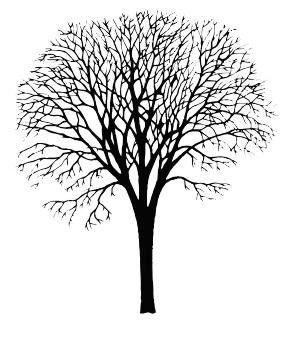

as summer winds down, long stretches of sunlight are dwindling and cooler temperatures are on the horizon. Gardening enthusiasts may wonder how they can manage their backyard gardens as the peak growing season comes to a close.
People may not be eager to do much in their gardens come august, particularly because the air may be hot and the dew point high. and spending the final days of summer at the beach or in the pool may take priority. However, late summer is a great time to focus on certain tasks.
Deadheading
Many plants look better with the wilted flowers removed. Furthermore, some plants, such as with lilies and roses, will benefit from having spent blooms removed so that no unnecessary energy is drawn away from the roots or bulbs. research your plants and learn which can benefit from some late-summer deadheading to keep them thriving.
Weeding
Weeds can become problematic if they’re allowed to grow unabated. routinely go into the garden and cull the weeds. Keep an eye open for pests according to Garden Smart, caterpillars and beetles may be chewing on garden plants
Tips to tend a garden in late summer
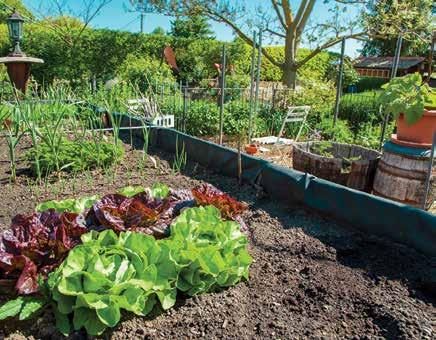
by late summer, and aphids still may be problematic. Handpick insects off of vegetables and ornamental flowers, or use safe sprays for treating these issues.
Plant cool weather vegetables
Many plants will grow well when planted in late summer, according to Homesteading Family. Some such plants include turnips, beets, carrots, kale, chard, mustard greens, and peas. you can begin turning your summer garden, or a portion of it, into a fall and winter garden.
Consider succession planting
Growing vegetables like beans or peas may be more successful if you try succession planting. This involves sowing new seeds every seven to 10 days to extend the harvest.
Harvesting what’s ready
Pick vegetables that are ready to eat, and remove any plants that have reached the end of their growing cycle.
Convert planter boxes and containers
This is a good time to start changing over summer annuals in containers and planter boxes to those that do well in fall, such as mums, asters, pansies, and goldenrod. There’s plenty of work to be done in the garden come the end of summer.

A guide to fall lawn care for cool-season grasses
Spring is the season most often associated with lawn care, and for good reason. Grass starts growing in spring, and the season is a great time to fertilize many grasses in the hopes lawns can look their best and endure the hotter, dryer weather of summer.
Spring might mark the time when many homeowners begin tending to their lawns each year, but it’s important to recognize the significance of fall lawn care as well. Grasses vary, and homeowners are urged to identify which type of grass is in their lawn so they can ensure it gets the care it needs before winter’s first frost. cool-season grasses like perennial ryegrass and Kentucky bluegrass are common in various regions, and the following strategies can help homeowners with these types of grasses tend to their lawns this fall.
• Stick to your recommended fertilization schedule. Homeowners who have been fertilizing since spring are urged to continue doing so in fall at the recommended interval. it’s easy to forget to fertilize in fall thanks to cooler temperatures that don’t call lawn care to mind and busier schedules after school starts again and
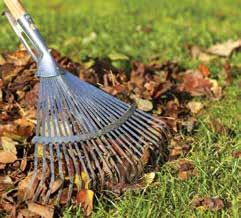
summer vacation season ends. But many fertilizer manufacturers advise users of their products to fertilize several times over the course of the year, including in fall. Stick to the intervals recommended on the packaging of the fertilizer you’ve been using, making sure not to forget to fertilize this fall.
• Conduct a soil test. a soil test can determine if the soil is lacking any nutritive elements it needs to come back strong in spring. certain amendments can restore pH balance if necessary and foster stronger growth when lawns come back in spring.
• Aerate, if necessary. Soil can become compacted over time, and that can cause a range of problems for a lawn. compacted soil can make it harder for water to reach the roots of grass, which weakens grass and makes it more vulnerable to damage during adverse weather events like drought. compacted soil also makes it harder for nutrients in fertilizer to get into the soil. aerating is best left to professionals, particularly in larger lawns, as the job can foster strong root development when done properly.
• Remove thatch where it’s excessive. Thin layers of thatch can benefit lawns by delivering nutrients from glass clippings and leaves to a lawn. However, when thatch is excessive, it can block air, water and even fertilizer from reaching the soil.
Thatch often can be removed with a rake, but lawns with especially thick layers of thatch may need to be scarified. Homeowners can take a Diy approach to scarifying or hire a landscaping professional to dethatch the lawn and remove the thatch from their properties.
• Continue to water the lawn. a

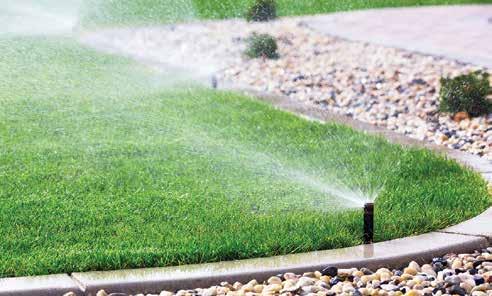
cool-season grass will continue to require water into the fall. Though the lawn won’t need to be watered as frequently in fall as in summer, various lawn care professionals note cool-season grasses still need roughly an inch of water each week in fall.
• Remove leaves as they fall. Fallen leaves can affect a lawn in much the
same way as excessive amounts of thatch, blocking water and nutrients from reaching the soil. So it’s best to remove fallen leaves, especially when they begin to fall in large quantities.
Fall is an opportune time to tend to a lawn to increase the chances grass grows back strong in spring.
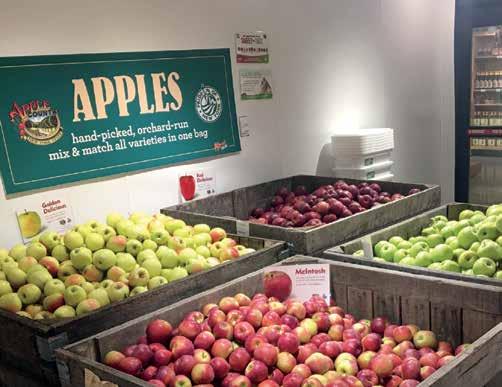



Tips to maximize closet space
Who couldn’t use a little more closet space at home? as individuals accumulate more belongings, they need places to store all of these items. While modern homes may be built with extra storage in mind, older homes often place a premium on closet space. Homes built earlier than the 1980s may have small closets in bedrooms and only one or two additional closets around the home for linens and other items. The most obvious solution to a lack of closet space is to build more closets. But too often home floor plans cannot accommodate new closets. Therefore, homeowners may have to get creative to maximize their space.
Sort and discard
individuals can take some time to empty closets and assess what is in them. Sometimes more space can come from simply thinning out belongings that are no longer used. Take off the plastic coverings on dry cleaning and discard bulky shoe boxes.
Invest in thinner hangers
clothes hangers come in all types, but the thinnest and most durable ones tend to be the no-slip velvet variety. Such hangers keep garments from slipping off and feature an ultra-thin design, says real Simple magazine.
Use storage containers
Grouping items together and condensing them can free up space. Tuck belts, handbags and other items into storage bins that can be labeled and stacked. loose items can look more cluttered and even take up more space when spread out.
Pair shelves with rods
For those with enough space, hanging a few shelves in unused areas in the closet can provide more storage space. if there is sufficient space above the rod, install a shelf and place seldom-used items up high.
Get a closet system
a customized closet system will certainly provide the best chances to maximize closet space. These companies will measure the closet and assess the contents to draw up a design that will give homeowners what they need. closet systems also can adjust and grow with lifestyle changes.
Choose other storage solutions
in addition to closets, people can identify other spaces to store items. This can include bins under beds, storage benches or ottomans, the back sides of doors, or in furniture with built-in drawers. individuals also can purchase free-standing closets or armoires that can fill in when rooms do not have enough closet space or no closet at all.
Maximizing closet space comes down to some creativity, de-cluttering and utilizing additional furniture to meet needs.
Did you know?
Professionals might be returning to work in offices after years of pandemic-related remote work, but that doesn’t mean home buyers aren’t still prioritizing home office space when shopping for a new place to call their own. according to a recent survey of home buyers conducted by the national association of Home Builders, 66 percent would prefer to buy a home with exactly one home office space and 13 percent want at least two offices. Just one in five buyers indicated they do not want any home office space. The majority of buyers who want home office space prefer a medium-sized space, which the naHB defined as between 100 and 150 square feet. Just 22 percent of buyers prefer a home office space larger than 150 square feet, while only 19 percent want a small space (less than 100 square feet). The naHB survey indicates the enduring popularity of home office spaces, recognition of which can be particularly useful for current homeowners preparing to put their homes on the market as well as those looking to add office space.

You Dream It, We Build It!



Nappi Tile and Marble

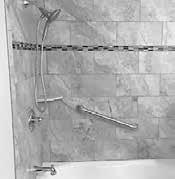


Remedies for creaky floors
Hardwood floors are coveted features in many homes. The national Wood Flooring association says wood floors are the most environmentally friendly flooring options available. in the United States, the hardwood forests that provide flooring products are growing twice as fast as they are being harvested. Furthermore, wood floors can last for many generations and require fewer raw materials to produce than other flooring options. That means less waste may end up in landfills.
Hardwood floors can endure for decades in a home, but over time those same floors may need some tender loving care to keep them looking good and working as they should. Squeaky floors are a common nuisance that homeowners may experience. Squeaking is often caused by movement and friction between floorboards. Treating the problem involves identifying the underlying issue.
Loose hardware
Squeaky floors may be due to the loosening of the hardware holding the floor in place, says The Home Depot. When nails or screws no longer are secured tightly, the boards can rub together. The noise heard is the sound produced by rubbing.
Flooring
Tightening or replacing the hardware can help reduce the squeaking.
Counter-snap kit method
This old House says this kit method is a great way to fix squeaks without damaging the floor. once the source of the squeak is located, drill a 3/32-inch pilot hole through the hardwood flooring.
Then insert a screw through the kit’s depth-control fixture and into the pilot hole, and drive it until it automatically snaps off below the wood surface. Follow this up by filling the hole with wood putty that matches the floor color. once the putty is dry, lightly sand the area to blend.
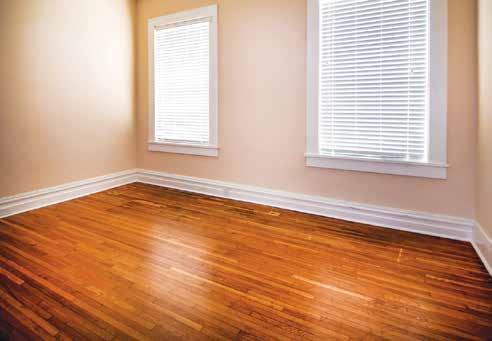
How to remove glued-down carpet
are some floors in your home covered with outdated carpet? if the carpet has been glued down, follow these tips to remove it and replace it with new flooring. Required supplies
Gather these tools to remove the carpet by hand:
• A mask to protect your lungs from harmful fumes
• Protective gloves
• A precision knife, such as an X-ACTO knife
• A pair of flat-nose pliers
• A scraper
• A sander
• Procedure
Keep in mind that removing glued-down carpet
requires physical effort while bending down, which could cause injury. Therefore, don’t remove stubborn carpet if you’re prone to back pain. Here’s how to do it in five easy steps:
1. Put on the mask and gloves
2. Use the utility knife to cut strips of carpet that are eight to ten inches wide
3. lift the edges of each carpet strip with the flat nose pliers
4. Peel off the strips one at a time using the scraper
5. once you’ve removed all the carpet, sand the floor
6. Don’t feel like doing all that hard work? rent a machine designed specifically for carpet removal.
Use a shim or shims
Sometimes the floor may squeak because of a gap between the joists and the subfloor. Filling the gap with a small piece of wood called a shim can help alleviate the gap or gaps.
Drive up screws if a squeak is just in one spot, The Home Depot says that you may be able to drive short screws from below into the subfloor.
Small gaps
For small gaps between boards, sprinkle talcum powder or powdered graphite between squeaky boards to reduce friction. Wood filler applied with a putty knife also may work. For larger gaps, use a liquid filler designed for wood floors.
Homeowners also can visit their local home improvement center for other hardware solutions designed for underfloor repairs to remedy squeaks. Many work from underneath the floor and involve mounting plates or brackets to sure up the floor.
Squeaky floors can be problematic, but noises can be banished with some repair work.

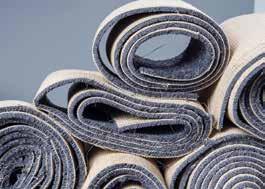
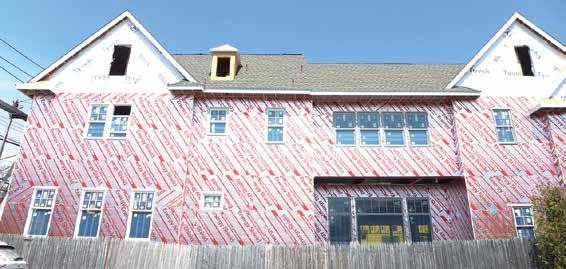
Explaining the siding replacement process
The longer a person resides in a particular home, the greater the likelihood that various components of that residence will need to be replaced. Driveways, roofs, HVac systems, and even appliances all have expiration dates. although siding on a home can be quite durable, there may be specific reasons why homeowners choose to or need to replace it at some point. Understanding what’s to come of the job can help homeowners prepare. no two siding jobs are exactly the same, and each project will be dictated by a host of variables, including which type of siding homeowners choose. However, these general steps are commonplace during siding replacement projects.
• Choose siding: Homeowners are urged to consult with various siding installation companies about which products are available and ask each for an estimate. Budget, climate and other factors will narrow down siding materials. The Home Depot says popular siding types include vinyl, wood, fiber cement, metal, and stone. Siding can have almost any color or texture as well.
• Remove and relocate: outdoor items close to the perimeter of the home will have to be moved out of the way so workers can access the siding. The job will require a dumpster to be dropped in front of the home or in the driveway to collect debris, so homeowners should be prepared to leave space for it.
• Siding delivery: The new siding should be delivered prior to the installation start day. These materials will take up a lot of room and space should be made available so the installation team can access them without difficulty.
• Interior decor: Siding installation will include hammering, which can disrupt items on interi-
or walls. it is best to have all wall hangings taken down to prevent damage.
• Old siding removal: on the first day of installation, removal of the old siding will happen first, according to Smart Exteriors. Siding, insulation and trim will be removed. in the event that older, asbestos-based siding is on a home, contractors may safely remove and discard it, or go over that type of siding. Homeowners should inquire about this step during the company vetting process.
• Home inspection: once all old material is gone, the exterior sheathing will be inspected to ensure it is in good shape. Signs of rot or loose boards will be considered and repaired, if necessary.
• New siding install: First workers will put on house wrap or some sort of insulation/water barrier product. afterwards, siding boards are layered on in the design chosen. nails or screws are used to attach the siding and seams will be caulked to prevent moisture penetration. if the homeowner has chosen to have gutters and downspouts installed during the siding job, those will be fitted and installed as well.
• Clean up: The installation team will begin the process of thoroughly cleaning up the property. all tools will be removed and the property will be swept or blown to clean away debris. crews typically use powerful magnets to grab stray nails and screws that have fallen into the lawn and elsewhere. The dumpster will be taken away shortly after the work is completed.
Siding replacement is a big job but one that can offer immediate curb appeal once completed. it typically is not a do-it-yourself project since it requires specific skills to ensure durability.
Tips for winterizing exterior living areas
When the summer entertaining season draws to a close, homeowners need to ensure their outdoor living areas can handle weather that’s right around the corner. although outdoor furniture and other items tend to be durable, the impact snow, wind and ice can have on them may lead to damage over time. That is why many homeowners take steps to winterize their outdoor spaces and protect their belongings. Here’s a look at how to prepare for the winter to come.
• Furniture: cover or store furniture to protect it from the elements. covering it with weather-proof covers can be adequate if storing items indoors is not possible.
• Deep clean: items that will be covered or stored should be thoroughly cleaned prior to being removed from spaces for the season. lingering dirt and moisture can cause damage.
• Insulate and drain: Don’t risk damage to pipes, which can freeze and crack in the cold. Shut off the water supply to exterior faucets and drain water lines to prevent pipes from freezing and bursting. Use foam pipe insulation to prevent freezing and cover any exposed pipes.
• Apply mulch: after cleaning up garden debris, think about applying mulch to garden beds and cover tender plants to protect them from the weather.
• Check gutters: Be sure that gutters and downspouts are clear of leaves and any additional debris. if gutters and downspouts are not cleaned, ice dams may form on the roof and cause water damage.
• Inspect and repair: inspect walkways and driveways for any damage and make repairs now so water will not seep in and cause further issues with freeze-thaw cycles. consider applying a sealant to protect surfaces from snow and ice.
• Pools and spas: it’s essential to follow the industry or manufacturer recommendations for closing down swimming pools and spas for the season. While covers may not be essential in all climates, covering can help prevent leaves and other debris from getting in the water. Water should be expelled from pipes and tubing to prevent freezing and bursting. if space allows, consider moving the pool pump indoors to prolong its longevity. Turn off the electricity to the outlet where the filter is plugged in. There may be additional, region-specific steps to winterize a property, but these pointers are a good starting point to protect outdoor spaces.
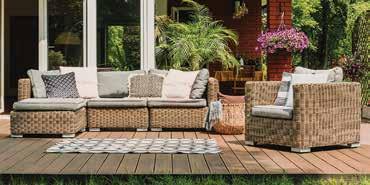
Keep pets safe this Halloween
Halloween is an annual celebration that many children and adults look forward to each october. From the mysterious and the macabre to the goofy and gregarious, Halloween speaks to people in many different ways. and with the opportunity to accumulate several pounds of sugary treasure after a few hours of trick-or-treating, is it any wonder celebrants love Halloween?
While Halloween hijinks may be ideal fun for plenty of ghosts and ghouls, companion animals may not be so enthusiastic come october 31. in fact, Halloween can be a source of stress and even dangerous for many pets. Here are some things pet parents should keep in mind prior to Halloween.
Costumes
Pet costumes are popular and can help owners and their pets coordinate for Halloween. Some pets may find costumes uncomfortable or frightening. For those with a mind toward creative costume coordination, introducing the costume to
the pet slowly and gradually can help ease the transition. allow the pet to sniff the costume and put treats nearby to indicate it is no threat. if the pet simply will not warm to the idea of a costume, it’s best not to force the issue.
Glow sticks
Glow sticks are a safe way for children to enjoy some spooky fun on Halloween night and become more visible when the sun sets. But those glow sticks may be attractive to pets and they can bite them, ingesting the liquid. The aSPca animal Poison control center says typically pets experience a mild and self-limiting taste reaction to glow stick liquid. Wiping off the excess with a damp cloth to help prevent the pet from licking again and having another reaction can help.
Accessibility to candy
one of the biggest Halloween dangers for pets is the accessibility of candy, especially chocolate. chocolate is toxic and particularly dangerous to dogs. chocolate with high amounts of cacao is especial-


ly dangerous. raisins and gum with the artificial sweetener xylitol also are problematic. candy wrappers can get stuck in the intestinal tract and cause a life-threatening blockage. lock candy away so pets can’t get into it.
Nerves
Many youngsters will ring the door bell on Halloween. anxious pets, and even
those that normally aren’t nervous with visitors, may be overwhelmed. Keep pets in a dark, calm room away from the door to reduce anxiety and make it less likely skittish pets will escape the home and get lost.
Understanding common Halloween dangers can help keep pets safe on this fun-filled holiday.



















